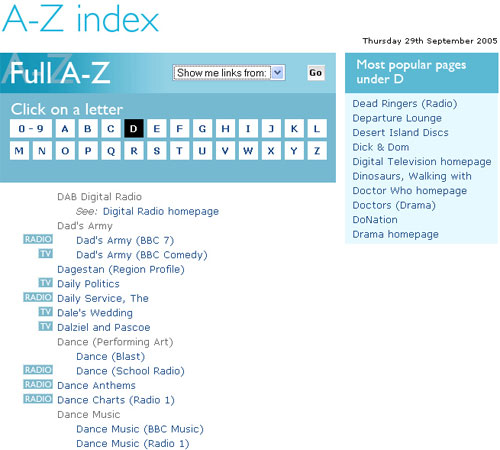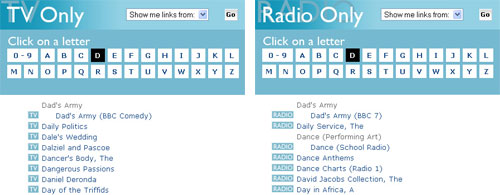Gaining Online Advantage: Classification and Indexing - part 7
This is page 7 of a 13 page article - 1 2 3 4 5 6 7 8 9 10 11 12 13
![]() Download a print version of this article
Download a print version of this article
Classification and Indexing
Again I would stress that if you are in a large organisation, for example a Government Department where business units have responsibility for similar areas of content production, it is really important when you put your site index together that you can expose these overlapping areas to the public, so that they can find the precise information that they need.
A classic example of this from the current BBC A-Z is the programme "Dad's Army". It is primarily known in the UK as a television sitcom. However some of the earlier episodes no longer survive as television programmes, but do exist as off-air audio recordings of the soundtrack. These have been broadcast on digital radio station BBC7

You'll notice therefore that in the A-Z index there are two entries for the "Dad's Army" programme brand, one marked with a TV label, and one with a Radio label, to distinguish that content for the users. It also sends a clear message to the rest of the organisation that the index aims to be comprehensive, and will list multiple content areas covering the same topic or brand. It isn't simply the case, as had been previously at the BBC, that the brand is mostly known as a TV show, so only the TV related content gets showcased in the A-Z.
The aim is that there is no major content area on the BBC site that you cannot navigate too by going from the homepage at bbc.co.uk, to the A-Z index, to the relevant page within the A-Z, and then direct to the content, making everything just 3 clicks away from the homepage.
So it is something to bear in mind, if you are putting a portal page in front of a body of information from a large organisation or business, you need to provide comprehensive navigational paths through to all your areas of content to enable people who prefer to browse rather than search to get to your content.
As I mentioned, this will also help with search engines - search engines need to navigate through a site to content in order to index it, and they do that by following links on pages. If you provide a comprehensive set of links to your content you are making it easier for pages to be retrieved by search engine robots, and consequently more likely that you will be indexed. As a bonus these A-Z links are excellent links for search engines, as the 'anchor' text is descriptive of the destination page.
On the BBC site the audience is given the ability to cut their view of the dataset in a couple of ways. Whilst I don't want to discuss taxonomy in depth in this article, there is a simple taxonomy behind-the-scenes of the A-Z in the content production system that produces these pages. This allows entries to be tagged as either TV or Radio programme brands. The audience can therefore narrow the index down to just TV, or just Radio content - and you can see the two separate instances of "Dad's Army" content are listed in their relevant sections.
